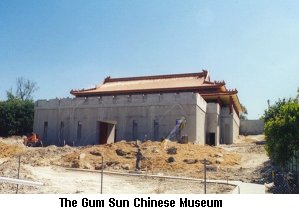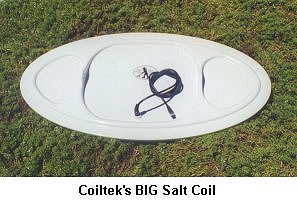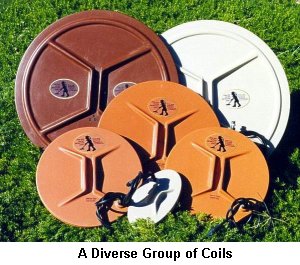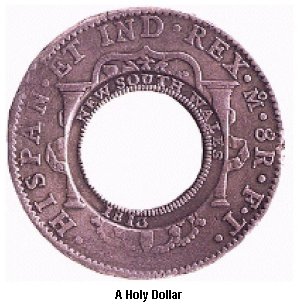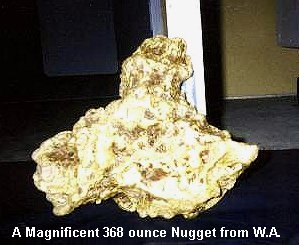
| March 2001 | ||||||||||||||||
|
||||||||||||||||
Contents
|
||||||||||||||||
1. EDITORIAL Welcome to The Australian Gold & Prospector's Expo. As you read this edition the gold expo will be in full swing at the Ballarat Exbibition & Entertainment Centre, Western Highway, Ballarat. Never before has such a concerted effort been directed at bringing all facets of this fabulous industry together in the one place. The legendary characters we all hear of but rarely see will be there in force. I am assured by several exhibitors that their stands will be exceptional in both product content and with the calibre of their professional personnel - many of whom are professional prospectors. Definately "Cutting Edge Stuff" I must thank those organisations and people who encouraged our endeavours. Such companies as Minelab & Coiltek. The support from the PMAV & APLA - has been overwhelming.
We will have some detractors - and we will have made some mistakes - but overall - we have finally "Got it together" for you. Finally - we mentioned last month that we had heard of a BIG nugget being found in Western Australia. Well it's confirmed. It was 368 ounces. Check it out in Strikes in this issue. I wish I could fine 'em that big. Editor Email: [email protected]
All material in this magazine is copyright and may not be reproduced in any part or form whatsoever without written permission from the publisher.
|
||||||||||||||||
2. THE GUM SAN CHINESE HERITAGE MUSEUM by Jim Foster
One Sunday in May 1857, seven hundred Chinese miners from Southern China, travelling overland from the Port of Robe, toward Clunes in the Colony of Victoria, rested at a spring on the eastern flanks of the Great Dividing Range, 400 kilometres east of Robe. Stretching five kilometres in length the find soon attracted the notice of the European population. Within weeks there came a Rush that saw the population grow to 30,000 frantic diggers. So rich was the Canton Lead that it yielded more than three tons of gold in the first three months. It was with the discovery of gold, that Ararat became the first Australian city to be founded by Chinese people. But not only were they Chinese, they were illegal immigrants. Victoria had become so concerned at the growing Chinese population it had introduced a poll tax of ten pounds to discourage immigrants from the Middle Kingdom. In response, many Chinese opted to be landed at Robe, in the colony of South Australia, where there was no poll tax. Their plan was to then walk overland to the Colony of Victoria, crossing the border at the northern end of the Grampian Mountains and evading the iniquitous racial tax. (In all, 16,500 Chinese walked into Victoria). In this way they became illegal immigrants to the Colony. Today, Ararat recognises these Chinese immigrants as the founder of their city.
THE CONCEPT To celebrate and acknowledge this historical fact the city of Ararat, with a population of only 8000, has raised the remarkable sum of three million dollars to build the Gum San Chinese Museum and Cultural Complex. While much of the money came from the Australian Government, a great deal of money, labour, and materials was donated by China and the Australian Chinese community. The most significant full scale Cultural Complex of its kind in Australia the Gum San will become a huge drawcard for international tourists, especially those from Asia. It will also become an extremely efficient and useful education facility for school children.
Consisting of two stories the building highlights the architecture of Southern China. The upper story will consist of a conference room, and a restaurant. The restaurant will be both outdoor on the wide balcony, overlooking the city and the mountains beyond, a view to rival any in the world. Landscaping in front of the facility is traditional Chinese. It consists of gardens. rockeries, and statues on a front sloping down to the Western Highway. Feng Shui has been incorporated in both the building and the gardens to great effect. MARKETING The Gum San trust has not just built a facility and hoped the world will beat a path to its door. They have taken an aggressive marketing position that will entice up to 30,000 people through the doors in the first year. In following ten years it is envisaged this figure could well be built to 90,000 visitors per annum. And with the busy Western Highway linking Melbourne and Adelaide passing in front of the facility this figure could easily be surpassed in under the projected time frame. For anyone who has any interest in gold, and the history of gold in this country, then the Gum San at Ararat is a 'must visit' destination. FOR DETECTORISTS The Ararat fields are still producing nuggets. Camping on the diggings in the forest to the north of town is popular while two caravan parks in town provide all the amenities including overnight vans, cabins, and flats. There are six motels and seven hotels within 1.5 kilometres of the site. The central Golden Triangle goldfields are only an hours drive to the east. FOR THE INTERNATIONAL VISITOR
Ararat is in the west of the state of Victoria, on the main highway connecting Melbourne and Adelaide, two hundred kilometres west of Melbourne. The city is built around and over the Canton Lead and its five kilometres of tunnels, shafts, and drives. OPEN TO THE PUBLIC It is planned that the Gum San will be open to the public in early March 2001.
|
||||||||||||||||
|
||||||||||||||||
3. COILTEK'S NEW SALT LAKE COILS byJim Foster Sheer cliffs frowned down upon us as we cautiously skirted their base of gleaming salt. Between the cliffs low sand dunes drifted fans of red out onto the dry lake bed. A breeze cooled our faces as we gazed out across the dazzling wasteland to where mirages shimmered in the midafternoon heat. We were here in this inhospitable wonderland of salt and heat to test the latest from Coiltek, a coil made specifically for use on the dry salt lakes of Western Australia. Prospecting dry salt lakes has always been a difficult task. There is the heat and glare often made worse by the winds that sweep unimpeded across the flats, and there is the isolation. But it has been the very salt itself that has been the barrier to detectors. Mineral salt combined with the many other minerals that lie beneath the thin dry crust have formed a barrier that causes most detectors and coils to emit a continuous scream when brought near the surface. But despite these problems gold has been found on these lake beds in large quantities since they were first detected back in the 1970's. But it has been mostly the larger and shallower nuggets that have been found, the deeper gold still remains down on the cap rock below a layer of salt and mud too deep for detectors to see, until now, that is.
The 18" salt lake coil has the ability to punch down through the salt and other minerals to find gold at depths never before realised. It is very quiet with only minor warbles as it crosses variations in salt mineralisation. It is also very sensitive with the smallest gold found by it this test being point three of a gram at about two inches. The 14" salt lake coil is even more sensitive but lacks the ability on that very deep ground to find the smaller gold. It is also very quiet to operate and very light and easy to use. DAY ONE AND TWO Our first afternoon on the lake was mainly exploring what was to us both a wonder and a delight. I had been on a dry salt lake only once, neither John or Len had experienced anything like it, while Steve, our guide, had spent many weeks finding gold on this and similar lakes. John set up the big 42 inch elliptical salt lake coil and commenced to grid an old patch on the lake bed. Pushing the trolley back and forth was easy and gridding just meant staying parallel to your last tracks with a slight overlap. John found only one small nugget there but was pleased with the coils performance. No more gold was found that first afternoon but everyone had seen where they wanted to go next day. At 6.30 am I was a kilometre away across the lake exploring an area where a good patch had been found before. While the coil performed well the same could hardly be said for me. By 9.30 am I was heading back across the lake into the teeth of a rising gale. Halfway across I gave up, shouldered my coil, and leaned harder into the wind. Len had beaten me back to camp and had watched with interest my progress from a distant shimmering figure to an exhausted tramping prospector. On reaching camp I threw myself down on my swag and resolved not to move again that day. Then Len saw John come around the near headland doing a little dance and waving his arms. "The bugger has found gold!" said Len. And sure enough he had. Two nice bits about three kilometres away. I groaned and begged a respite before setting out again. While I rested John made a big mistake. The gold, he said, was not on the lake bed but on a tongue of rubble washed out from a gully. As he spoke he removed his 18" salt coil and replaced it with a 14" DD. I was too stuffed to bother replacing my coil. FIRST PATCH
On arrival John showed me where the gold was found and left me to it while he helped Steve retrieve the trike which had broken down. (Steve had been dragging the big elliptical behind the trike searching for a patch for us but the break down meant we were on our own.) I immediately found a nice two grammer then opted to leave the small area for Len to have a go. DAY THREE Steve had used the 18" lake coil the night before to target some signals on a patch that had previously yielded him several ounces of nuggets. The others were off looking elsewhere so I offered to help Steve dig the targets. But before that I tested the 14" salt coil over each marked area and found no real signal evident, yet the 18" salt coil said there was a definite signal at most of the fifteen spots marked. The lake bed at this spot was fairly deep, up to twenty inches. The first target was deep in the gluey grey mud. Hitting bottom we were mistified to lose the target. It was only later that Steve found the nugget, it had been stuck to the shovel. At this point John joined the hunt and I headed off to answer a call of nature. Even at times like these it pays to take your detector.
HOT AND WINDY The following week saw us on another dry salt lake, a bit smaller this time as we could actually see the far end. We now had a larger party as Brian and Ben had joined us. We searched this lake and the surrounding countryside but found only one small patch of gold - right next to camp. I found this patch because I was last to move out and didn't feel like walking for miles. Laziness does sometimes have its rewards. Next day we cleaned the patch out and tried to hide from the afternoon sun, but with strong north winds and forty-degree heat we didn't have a hope. Shifting camp to what we hoped was the more sheltered spot of the previous week we settled in and began exploring further afield. One small patch of four nuggets was found then another of twelve, but despite Steve covering an immense amount of ground towing the big coil behind the trike no more patches were found. Hiking out across a salt lake in forty degrees heat is an experience not to be taken lightly. You have to carry plenty of water as the heat and constant wind dries you out at an incredible rate, I've never drunk so much warm water in my life. But despite the hazards we tramped for kilometre after kilometre, at times we were so far apart only an indistinct darker spot could be made out among the shimmering haze. Finally the heat drove us back to camp where we decided on one more hour before breaking camp and heading for town. LAST GOLD Along the lake edge from camp I waved the coil looking for one last nugget. By now the wind had risen to a shrieking force that threatened to tear the earphones from my head. The sun beat down brazen on the wind driven dust and haze while the sky and land took on a washed out look that worried me. Suddenly a signal! A good solid signal that got louder as I dug through the goo that insisted on sticking to my digger. It was a lovely bright 2.5 grammer sitting right on the rocky bed of the lake. Then John got an eight grammer only a few metres away. Both nuggets were only about ten inches deep. We worked the spot for a while but got no more. Steve was astounded that we'd found gold there. He showed us where he had found a nice nugget on the edge of the lake then carefully grided the area both ways and finding no more gold. He would, he said, have put money on there being no gold there. We left the lake soon after that last nugget, the wind and heat both increasing in intensity, but still we were reluctant to leave, the lakes had cast their spell well, we will be back - with lake coils. IN CONCLUSION Despite not finding a great deal of gold with the 42" eliptical lake coil Steve was immensely impressed with its performance. He is convinced that it is only a matter of passing the coil over a patch and it will be his. I agree one hundred percent. By the time you read this story Steve will have found several good patches. We were all impressed by the ability of the 18" lake coil. It is light and easy to use. The 14" lake coil is also light and easy to use. It is quiet and sensitive with good depth, but does not come close in depth to the 18". Despite this I managed to find 18 nuggets with a total weight of just under two ounces using this coil. While the lake coils are incredible on the salt lakes they are not designed to be used on laterite. They will work on normal laterite ground, but not as well as the double D's or mono coils. However, there is one more advantage that these coils have over standard coils, they work very well under power lines. If I lived where I could spend a lot of time detecting salt lakes I would have all three coils. I predict with great confidence that over the next year there will be millions of dollars worth of gold found with these coils on the lake beds of Western Australia, I just hope there will be some left for me when I get back there next year.
|
||||||||||||||||
|
||||||||||||||||
4. PROFILE - BRAD WILLIAMS by Laurelle Murphy I have known Brad Williams for perhaps 12 years. Brad was born in Adelaide at the end of WW2. He was educated at Prince Alfred College after which he went to Sale in Gippsland where he learnt the trade of a dairy farmer, on his uncles irrigation farm. Returning to the family dairy farm at Macclesfield, in the picturesque Adelaide Hills he managed that property for three years. In the early 1960's dairying was not a profitable venture, and as his father had several business interests in Adelaide - this property was sold, and a move back to Adelaide was made.
Brad needed a job and found work as a labourer for a few months before joining the police force, thus becoming a member of the constabulary. Although this was not his chosen profession - he remained in that position for the next 21 years. Rising very quickly to the rank of Senior Sergeant in charge of almost half the Adelaide metropolitan area.
After selling this business Brad took 12 months off - during which he travelled extensively within Australia - to Perth - Darwin - Sydney - Melbourne - and to the gold fields region of Victoria and New South Wales - where this interest intensified. Rather than sit and vegetate, Brad chose to consider prospecting as a serious hobby and maybe even as a full time activity. Making some enquiries he was referred to John Gladdis who was at this time working for Minelab. There were three or four meetings with John G, and a couple of field trips into the Victorian Gold Fields where Minelab 2100's were hired and waved about with reckless abandon. Those trips became more frequent - but still some other interest was needed to feed the underchallenged one. As Brad had been learning to use and write internet language for a year, the concept of an Australian Internet site spreading the word to the world about Australian Gold was conceptially conceived - and following consultation with several of the main players in the industry - Gold Net Australia Online was born in February 1999. The web site was developed originally with professional help - but today Brad administers the site himself. Jim Foster and Brad joined forces with Jim becoming the "Editor", of Gold Net Magazine. Several other writers contribute to the magazine, and in that two years has achieved a readership of several thousand - and reaches as far away as the Sahara in Morocco. Alaska in the USA. New Zealand, Malaysia, Lithuania, Turkey, and the Antarctic - to name just a few places where the magazine reaches.
The Gold Expo was planned some 6 months ago - and the enormous amount of work being undertaken at this time almost precluded me from getting some details from Brad - but time was found for me. Brad has a number of other business interests and owns a telemarketing business which is growing quite rapidly. A keen user of the internet - other web sites are being developed in a similar vein to Gold Net for businesses with global market potential. Brad has had extensive interests over many years, including horse breeding, and enjoys rural pursuits, and of course detecting. Hobbies include photography and, politics - to a degree - I am told. He lives in Adelaide - has a daughter who is completing a doctorate in Musicology at Adelaide University, and a son who is a Police Officer. His regret is that he no longer has the time to devote to detecting, and he finds that a frustrating impediment. However, in the future he is planning a long retirement in the gold fields.
|
||||||||||||||||
|
||||||||||||||||
|
5. HORSES FOR COURSES  by Jim Foster Prior to the introduction of the Minelab SD2000 detector, little emphasis was placed on search coils. Often a detector would be purchased with one coil, and it would never be changed. Today, things are very different indeed. Not only does the detector operator need the latest technology in detectors, the latest in search coils is also required if the level of finds is to be maintained. Those who persist in using only one or two coils will always leave gold behind. Last year we met an operator who used a SD2100 fitted with an 11" monoloop. He maintained that was the best combination. Finding a small patch he was rewarded with half a dozen nuggets weighing less than an ounce. A week later we stumbled on his abandoned patch. Using her 14" DD Coiltek coil Cheryl found two nice nuggets. I went over it with the 18" DD after she had finished and found several more nuggets. Altogether we found more than an ounce of gold, more than the original finder.
As the ground on that patch had been heavily mineralised, and covered in 'hot rocks,' we found the patch covered in holes. Using DD coils we dug no hot rocks and only a few scrapes for hot ground.
While a 2100 gets more out of a mono coil than a 2200, it is also true that I find a DD coil works better on the 2200 than the 2100. Don't ask me why, I just find that is the way it seems to me. A spot I am looking forward to this year is a patch I found last year. We got good gold off that patch but not one of those nuggets was lying on caprock. Realising there was probably more gold, deeper, I attempted to search it using the UFO. This attempt to get deeper failed as the ground was heavily mineralised and salt saturated. This year I'm going back with a 24" elliptical double D coil to get that deep stuff. When checking the depth of the ground you are searching remember, on a slope the ground cover over bedrock, or caprock, will be shallowest at the top of the slope. The further downslope you go, the deeper the ground. Last year I was detecting a slope that had seen many years of detecting, and no doubt a lot of gold had been found there. Chaining across the higher parts of the slope I used my 14" DD as the entire slope was heavily mineralised. Even on the shallower ground I found nuggets up to half an ounce. When the ground got to about 10 or 12 inches deep I changed from the 14" DD to the 18" DD. The ground there never got any deeper than about 18 inches but I continued to find gold as I finished chaining right down onto the flat. Altogether I got over ten ounces of gold off that slope, gold that should not have been there. And would not have been there had previous operators used the right coil for the job. Remember, If the ground mineralisation is light, use a monoloop. On shallower ground an 11" coil will work very well. A 14" won't have quite the sensitivity, but will have considerable more depth. The same applies for larger mono coils. The bigger the coil, the more depth, but slightly less sensitivity. That is until you come to the 24" UFO. It combines the sensitivity of the 14" mono with the depth of a round 24" mono. And it is the most stable of the larger mono's. Should the ground you are working have too many hot rocks, or hot clay domes, don't hesitate to switch to a double D coil. So stable are DD coils they are largely unaffected by hot rocks, and hot ground. This stability is reflected in the quietness of operation. Being so quiet you can easily hear those faint signals from deep, or small nuggets. Using a mono you may not be able to pick up those signals through the masking ground noise. For those searching for gold in the West, Coiltek's new salt coils will ensure you no longer have to put up with the head splitting noises your old coils make on the salt lakes. No doubt, you can argue, your old coils found a lot of gold. but these new ones will enable you to go back over patches and find the gold you missed. They are as sensitive as anything you have previously used, but they make no more spurious noises than a DD coil on average sort of ground. By using your coils intelligently you will find more gold. You will find it deeper, smaller, and more often. Any new coils you buy will pay for themselves many times over when used correctly. And it doesn't matter whether the machine you are using is a SD2000, 2100, 2200, or a GP Extreme, it's the right horse for the course that put the most gold in the bank.
|
||||||||||||||||
|
||||||||||||||||
6. HOW MUCH GOLD by Jim Foster In the first ten years of gold rushes, 1851 to 1861, most of the gold recovered was alluvial. It was often shallow, and easily won in large quantities by the wildly enthusiastic diggers. Many huge nuggets were found during this period, but most disappeared without trace, sold to the gold buyers and melted down. After all, who cared? It was only gold. Just a bonus on top of the harder won fine gold. You couldn't eat it so it had to be exchanged for something more easily transported and converted into things required. And while these larger lumps of gold were a nice bonus, it was the smaller gold that was most plentiful.
During that first momentous ten years, enormous amounts of gold were shipped out of the country.
As a result of the flood of gold out of the goldfields, part of the old Rum Hospital in Macquarie Street, Sydney, was converted into Australia's first mint. Estimates put the flow of gold into the mint at one million ounces. Opening on the 14th of May 1855 it produced an enormous number of gold sovereigns, establishing an Australian currency that remains, even today, in the form of many coin collections throughout Australia, and the world. Should you have in your possession a Sydney mint Sovereign from this era, you then own some of the first gold mined in Australia. Before the minting of gold coins began in Sydney, Australia had no coinage of its own. Instead, coins from all over the world were in use, including the famous Holy Dollar and Dump. Smaller denominations of coins continued in such great shortage for many years that storekeepers issued their own tokens in change from coins of higher value. Many of the tokens are still in existence in coin collections around the country. Many more languish in the bottom of drawers and buckets, where they have been thrown by prospectors who have found them with detectors but not bothered to do anything with them, despite their great historical connections. The first recorded shipment of gold to England left on the 23rd of July 1852 on the ship, Mary Bannatyne. It weighed 280 pounds and was considered to be of immense value at the time. No accurate records were ever kept of the amount of gold produced in the Colonies. Nor was any kept on the amount shipped out by private companies, Banks, or individuals. In the 1860's a London report is reputed to have said: "The quantity of gold that has poured into England, from Australia is immense. And what has become of it all is often a matter of considerable conjecture, although much has been sent to the Mint and even more sent to foreign countries in exchange for their gold coinage". In the Great International Exhibition of 1862 a gilded pyramid 3.048 metres square at the base and 13.7 metres high was built to represent the mass of gold exported from Victoria between 1st of October 1851 and 1st of October 1861. Had this pyramid been solid gold it would have weighed 26,162,432 ounces. Or over 740 tonnes.
|
||||||||||||||||
|
||||||||||||||||
7. FLECKS ! - Glints from here and there
|
||||||||||||||||
S.A. METAL DETECTING CHAMPIONSHIPSPALMER ROCK - A - RAMA 2001 The Murray Bridge & Districts Gem & Mineral Club will be holding the PALMER ROCK - A - RAMA at Collier Park, Palmer on the Long Weekend of 19th 20th 21st May 2001. MAJOR SPONSORS are: COILTEK - MINELAB ELECTRONICS - MANNUM MINERALS - REMLAP. The competitions will run on Sunday 20th - with two detecting sessions planned for the day. A second smaller competition will be run on Monday 21st. - with this day being a FUN day.
Entry fee is $10.00 per session for open classes.
Campsites available - $35.00 for 3 days. No power - but generators are OK.
|
||||||||||||||||
|
||||||||||||||||
8. STRIKES Recent Finds
|
||||||||||||||||
|
||||||||||||||||
|
9. THE NEW LODE - Next Month's Issue
|
||||||||||||||||
|
||||||||||||||||
